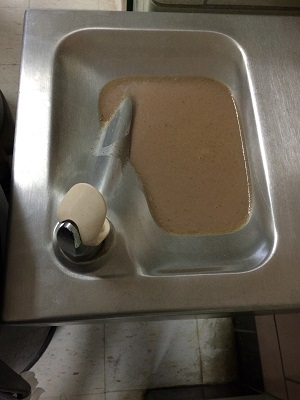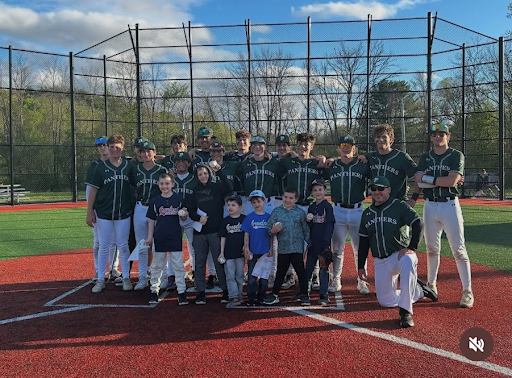What’s Wrong with the Water?

What’s wrong with Pentucket’s water? More like what’s not wrong with it.
Water at Pentucket has long been considered unsatisfactory by its students. In order to avoid drinking from the fountains, most students bring a bottle to school each day or opt to buy water from the cafeteria or the nurse. In a student survey, the school’s water was rated a 3.3 out of ten, with ten representing the highest quality of water.
Hydration is vital to the health of adolescents. The human body is made up of 75% water and the body’s percentage of water allows it to function properly and at peak performance.
Dehydration in teens can cause headaches, fatigue, and poor concentration. These ailments are often blamed on stereotypical teenage behavior, but teens may actually be suffering from lack of hydration.
Pentucket’s school nurse, Mrs. Therrien, says that headaches are commonplace in her office. She attributes their prevalence in the student body to teens not getting enough to drink. It is fully possible that students are not keeping hydrated because they refuse to drink the water from the fountains.
Many students say that although they try to keep hydrated by bringing their own water, when their bottles are empty they find themselves without anything to drink. Sophomore Hayley Palermo says, “I always bring water to school, but if I ran out I would want to have something to refill it.”
Most students avoid the water on principle. Freshman Anna Dixon says that she only drinks from the fountains if she is extremely thirsty, and sophomore Ellison Seymour says that she has never drank the water because she “doesn’t trust it.” Ellison even describes the water as “infected.”
Students dislike the water for good reason. The water has a “grimy aftertaste,” says Palermo.
Dixon agrees, going on to state that the water tastes “strange, with a weird hint to it.”
It seems to be an almost unanimous opinion at Pentucket that the water is only to be drank if necessary. Gabby Blake, sophomore, says she has only had a drink from the school’s fountains once, after completing the dreaded Pacer in gym class freshman year. She describes that her lungs felt like they were “undergoing fusion,” and that she regrets drinking the water, saying she would have “literally rather combusted.”
Noah Elias-Guy, sophomore, is known by fellow students to drink large amounts of the school’s water, a rare occurrence in the halls of Pentucket. Because he participates in track, Noah estimates that he drinks, “Ten times more water than the average person,” often drinking from the fountain up to four times a day.
Noah seems to have accepted the state of Pentucket’s water. He makes it clear that although he does not think that the water is up to standard, his need for a drink is more urgent. “As I’m drinking the water, I’m thinking, ‘This is the worst water I’ve ever drank. But you have to weigh the good with the bad. Hydration is good, the water is bad,’” he says.
Students aren’t the only ones affected by the school’s water; teachers are as well. Chemistry teacher Mr. Goguen is very upset with the condition of the water. Water is essential to his class, as it is a main component in many different experiments.
In order to create deionized water for the chemistry labs, the school’s water is run through a filter. Mr. Goguen says, “The filter is no good because the water is so bad,” going on to explain that the filters that deionize the water are constantly clogged with contaminants.
Mr. Goguen says he often drinks the deionized water instead of the water from the fountains, stating that “pond water would be better [than the school’s water].” He says that while the water is potable, he would not recommend drinking large amounts of it. (Sorry Noah!)
Not only is the quality of the water at Pentucket questionable, but the access that students have to hydration is limited as well.
Regulations are set in place on both a federal and a state level to ensure that all students are able to have water easily accessible to them during the school day. Massachusetts state law requires all schools to maintain a ratio of one water fountain for every 75 students. Pentucket’s student body currently consists of approximately 730 students. This means that in order to meet state regulations, Pentucket must have ten working water fountains.
Pentucket has a total of 11 water fountains, but at this time, only seven are functioning properly. The other four fountains lay in various states of disrepair. Not only do the broken fountains not have water, almost all of the bubblers are tinged with a mysterious green color. Whether these fountains are encrusted with corroded paint, mold, or algae, one will never know.
When taking a walk around the school, one could find a fountain filled with a substance that looked suspiciously like chocolate milk, and another with a discarded tortilla chip laying in soggy pieces by the drain. Not only is this extremely unsanitary, it is deeply saddening that this is not an uncommon occurrence at Pentucket.
It is considered general knowledge at Pentucket that many of the school’s water fountains are out of order. The school’s failure to comply with state law calls for drastic action.
Mr. Seymour, principal, brings up an interesting idea, saying that he would like to “install water fountains that are designed to fill water bottles, not drink from.” Seeing as many students already bring their own bottles to school for their own convenience, this would be an great way to improve the water situation at Pentucket.
It is obvious from the opinions of the student body and staff that there is definitely a lot wrong with Pentucket’s drinking water. Whether it be in the form of new fountains or better filtration systems, the school’s water system is in need of a serious upgrade. As it is clearly an issue that is important to many in the school community, action must be taken in order to fully secure the health and happiness of both teachers and students.
Citations:






